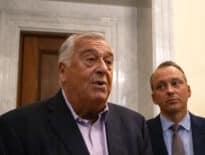
Crews work on MBTA Orange Line tracks at the agency's Wellington maintenance facility on Aug. 3, 2022. State House News Service photo | File
The MBTA is planning to unleash a year-long campaign of maintenance shutdowns to eliminate the slow zones and other track headaches that have bedeviled subway riders for over a year.
MBTA General Manager Phil Eng told a subcommittee of the agency’s board of directors Thursday morning that the plan will kick off with a nine-day attack on slow zones in the Green Line’s central tunnel in downtown Boston and Back Bay starting the week after Thanksgiving, as well as evening and weekend closures on a few segments of the Red and Orange lines.
That maintenance surge will see the Green Line shut down from North Station to Kenmore Square on the C and D branches, to Babcock Street on the E branch and all the way to the Heath Street terminus on the E branch. The work will also include fixes for power failures that have plagued Green Line riders all fall, Eng told the MBTA Board’s Safety, Health and Environment Subcommittee.
Another shutdown of the D branch between the end of the line in Newton and Boston’s Kenmore Square will follow in December before the full repair program begins in earnest in January, with different sections of the T’s four subway lines being closed at different times of year for anywhere from part of a week to nearly three weeks in two cases.
Shutdowns like these are necessary, Eng said, to give workers enough time to efficiently fix the dozens of problems that have piled up in the T’s subway lines over the years.
“The lieutenant governor [Kim Driscoll] said something: Short term pain for long-term wins. That’s what we’re trying to do,” Eng told the board.
Builds Off October Lessons
Eng said the campaign would build on lessons from the successful two-week repair shutdown of the Red Line’s Ashmont branch and the associated Mattapan trolley line in October. An analysis by watchdog group TransitMatters found that work got trains moving faster than their pre-pandemic speeds and eliminated all but one slow zone. During his presentation, Eng also noted that the T did additional work on the branch to replace other items it new would become an issue in a few years.
The 2024 shutdown schedule was designed around major construction projects, public holidays and events, MBTA Chief Engineer Sam Zhou told T board members.
“We plotted out the chart, the calendar, to make sure we minimize the impact to riders. That’s always our one of our top goals,” he said. “There’s also flexibility being built into this, so down the road [if] any major events take place that we haven’t considered, if after the outage we get positive feedback, constructive feedback, we’ll incorporate that.”
Following the Red Line shutdown, the T still has 191 slow zones in its subway system, Eng’s presentation noted, costing riders extra time and making trains significantly less reliable.
Slow zones are put in place on segments of track that have deteriorated so far, thanks to inadequate maintenance, that trains can no longer safely run over them at full speed – a problem Eng in his Thursday presentation suggested was due to atrophy in the agency’s maintenance workforce and which transit advocates have noted can be partly blamed on a lack of state funding for repairs in years past.
Eng told T board members that the 2024 maintenance campaign would be paid for using existing T resources, including money that the state legislature had given the T to fix problems identified in last year’s stinging federal safety investigation, adding that “if future needs result we’ll handle that as it arises.”
T Aims for ‘Proactive’ Future
During Eng’s presentation, MBTA board member Bob Butler called out the average age of tracks and signals on the T’s subway lines – 28 years and 32 years, respectively.
“I knew we have an old system but looking at these years [of age], it’s just insane to me,” he said.
“This is the same for our rolling stock,” Eng replied, using a transit industry term for the T’s trains. “It’s the same for our infrastructure. It’s the same for our stations. We need to get ourselves on a much more aggressive program where we’re addressing these before it becomes an issue. That goes to us becoming more proactive, becoming more efficient.”
TransitMatters and other advocates have called for several months for Eng to release a roadmap for future repair work so riders and businesses would be able to plan ahead and so the public could start rebuilding its confidence in the T after a month-long maintenance shutdown of the Orange Line in 2023 under different leadership left the line slower than it was before the shutdown.
In a statement, Kate Dineen, president and CEO of business-backed advocacy group A Better City, called Eng’s plan “a critical step” and “decisive action to get the system back on track after decades of underinvestment” that “has the potential to restore rider trust, bolster our region’s economic competitiveness, and promote more climate-friendly commuting options.”
Greater Boston Chamber of Commerce President and CEO Jim Rooney, himself a former top T official, echoed Dineen’s positive review.
“Today’s announcement demonstrates a new and strategic MBTA commitment to important repairs necessary to eliminate slow zones that will bolster service for the region. The detail, clear goals, and deadlines in the plan mark an encouraging – and much needed – shift towards greater transparency and accountability by the T,” he said. “With the Healey-Driscoll administration and General Manager Eng’s leadership and today’s announcement, there is more confidence and trust building in the future of the T.”
In addition to getting trains working as fast and reliably as they did before the pandemic, the system overhaul will also spin off benefits for the agency and riders going forward, Eng and Zhou said. Most critical will be the creation of a new internal task force, recently stood up by Zhou and set to be led by his fellow Eng appointee Chief of Infrastructure Doug Connett, that will make sure the T is doing preventative maintenance regularly, to prevent the subway system from falling into the same maintenance pit as before. The T will also be exploring ways to reduce the impact of future maintenance shutdowns, like only working on one of a tunnel’s two tracks at once to let trains continue to operate on the line, albeit at a potentially lower frequency.
Eng called the approach “a new way of doing business for the T.”
“Every employee at the T plays a key role in this,” he said. “Everybody has a role and is accountable for that role and our goal is to have open communication. The goal is that we solve problems timely, that we solve them proactively and when we encounter them that we share them publicly.”






